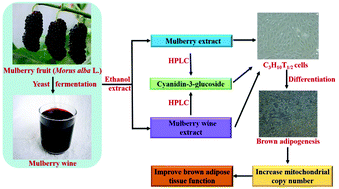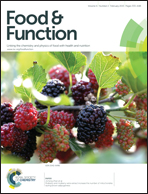Mulberry and mulberry wine extract increase the number of mitochondria during brown adipogenesis†
Abstract
Mulberry extract (ME) has been shown to possess beneficial effects towards obesity, but its mechanism is still unclear. In small mammals, mitochondria enriched brown adipose tissue (BAT) is known to convert protein's electrochemical energy to heat and maintain a constant body temperature. Improving the mitochondrial function or increasing the number of mitochondria could promote the metabolism of carbohydrate and fat. Thus, this study was designed to investigate the mitochondrial function regulated by ME and mulberry wine extract (MWE) during the brown adipogenesis. The C3H10T1/2 mesenchymal stem cell was treated with ME and MWE, both of which significantly (p < 0.05) increased the expression levels of fatty acid oxidation related genes such as peroxisome proliferator-activated receptor-γ coactivator-1α, PR domain-containing 16 and carnitine palmitoyltransferase 1α during brown adipogenesis. These changes were accompanied with increases in mitochondrial oxidative complex proteins upon ME and/or MWE exposure. Notably, ME and/or MWE also significantly (p < 0.05) increased the expression of the transcription factor A and the nuclear respiratory factor-1, which are the key transcription factors of mitochondrial biogenesis. In parallel, the mitochondrial copy number and brown adipose tissue specific gene-uncoupling protein-1 expression were dramatically (p < 0.05) elevated after ME or MWE treatment. Cyanidin-3-glucoside (Cy-3-glu) was found to be one of the most abundant anthocyanins in ME and MWE. Therefore, the BAT regulatory activity of ME and MWE might be, at least in part, due to the effect of Cy-3-glu. These results suggested that ME and MWE could ameliorate metabolic disease through an improvement in mitochondrial functions.


 Please wait while we load your content...
Please wait while we load your content...